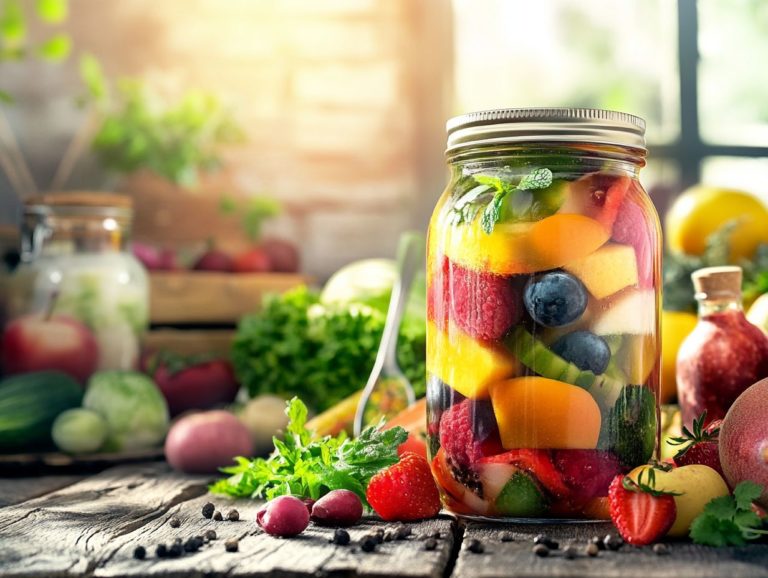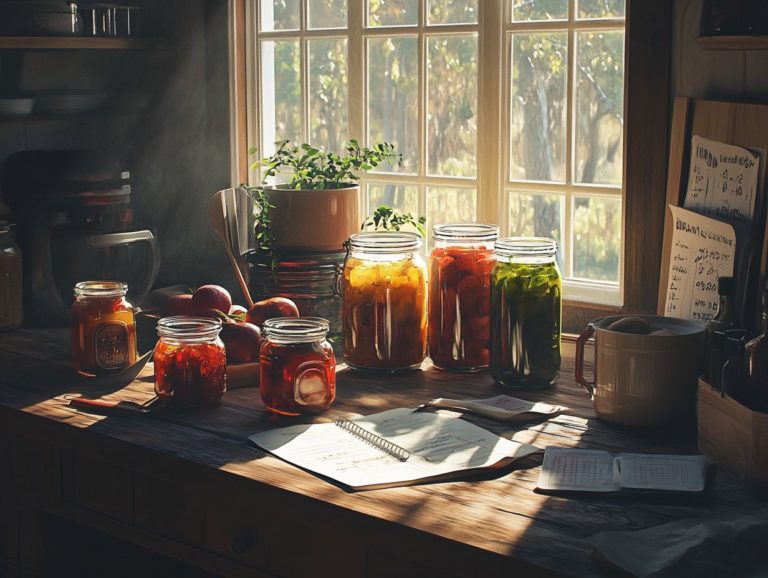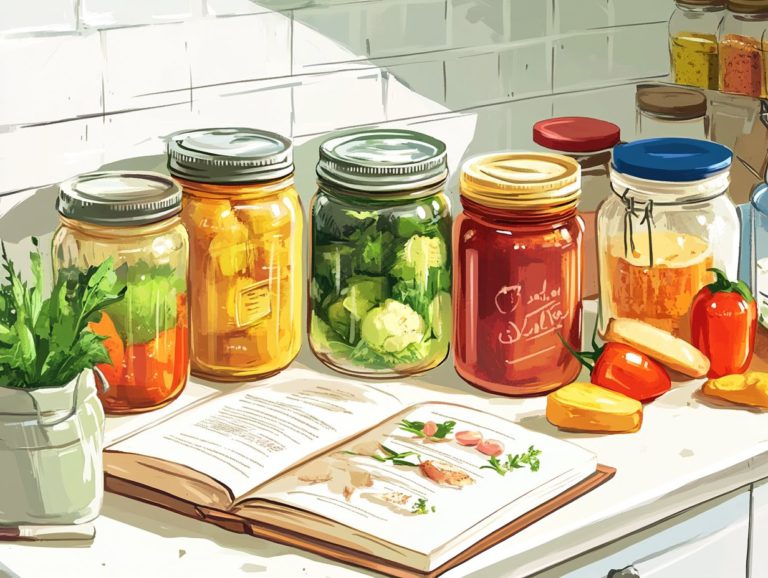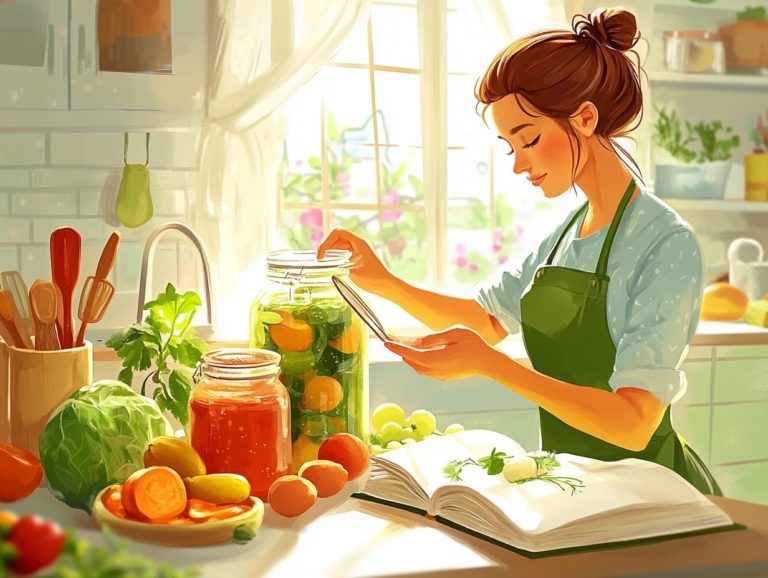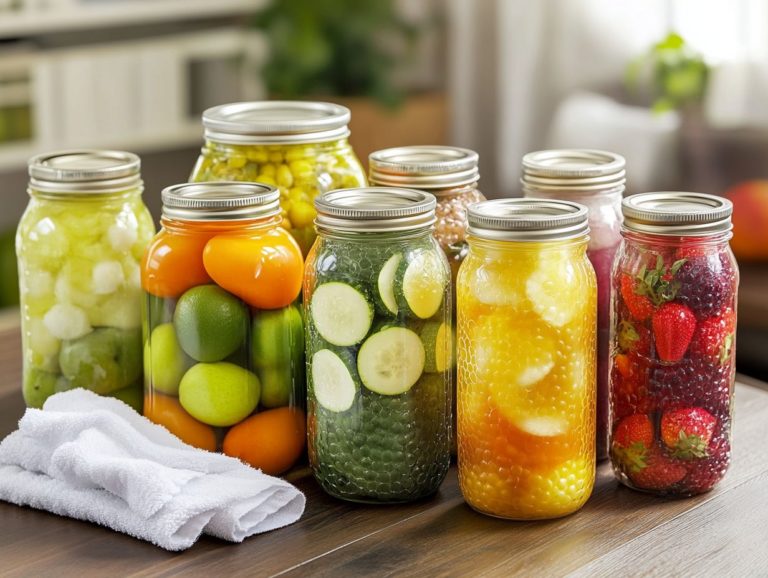Dealing with Overcooked Canned Fruits
Overcooked canned fruits can indeed present a culinary challenge, often leading to mushy textures and a significant drop in flavor.
In this article, you’ll uncover the common culprits behind overcooking and learn to recognize the telltale signs that your fruits may have gone too far. Essential tips for refining your canning techniques await you, along with strategies to revive those unfortunate fruits and inventive recipes to give them a new lease on life.
Discover how to turn kitchen missteps into delightful culinary creations!
Contents
Key Takeaways:
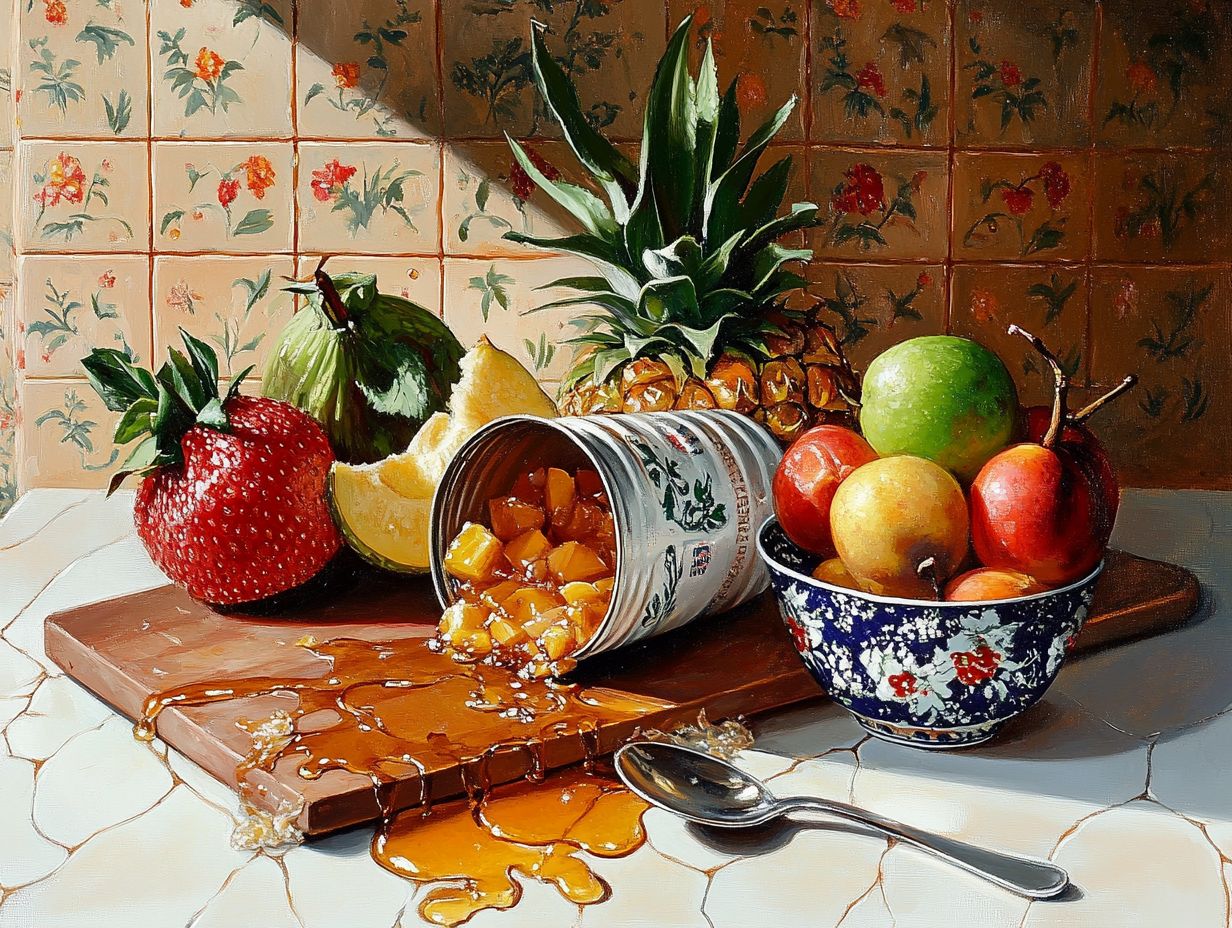
- Overcooking canned fruits can result in loss of flavor and texture, making them unappetizing.
- Common signs of overcooked canned fruits are mushiness, darkened color, and loss of shape.
- To avoid overcooking, follow proper canning techniques such as using a timer and monitoring heat levels, especially during humidity.
Understanding Overcooked Canned Fruits
Grasping the nuances of overcooked canned fruits is crucial for anyone passionate about preserving the essence of sweet, ripe fruits think blackberries, peaches, and the like in delectable jam recipes.
When jam is overcooked, it tends to become thick and loses the vibrant texture and flavor you aimed for. This often results from incorrect cooking times or miscalculated points where the jam sets. By understanding what causes fruits to become overcooked, you can sidestep potential jam disasters and truly master the craft of jam-making.
With these tips, your homemade biscuits and barbecue dishes will impress everyone!
Causes and Effects of Overcooking
Overcooked jam often arises from exceeding the recommended cooking time or misjudging the point where the jam sets, resulting in textures and flavors that are far from delightful.
Common culprits of overcooking include using excessive sugar, which can throw off the cooking dynamics and lead to a syrupy consistency. Cooking at incorrect temperatures can also hinder proper water evaporation. Take blackberries, for instance; when overcooked, they can morph into a thick paste instead of preserving their signature juicy texture.
To avoid these pitfalls, it s crucial to keep a watchful eye on the cooking process. Employing a food thermometer ensures the mixture reaches the desired temperature, while the spoon test provides an accurate gauge of the gelling stage. By paying careful attention, you can achieve a perfectly balanced jam that captures the vibrant taste and appealing consistency of the fruits you ve chosen.
How to Identify Overcooked Canned Fruits
Recognizing overcooked canned fruits is essential for maintaining the quality of your homemade jams. Look out for indicators such as an excessively thick consistency, a caramelized flavor, or a discolored appearance.
These signs suggest that the point where the jam sets has been exceeded. Addressing this can make all the difference in your final product, especially in your cooking methods for jam.
Signs and Symptoms of Overcooking

The signs that your jam has been overcooked can be quite telling. You might find it s developed a thick, syrupy consistency, an unusual taste, or even a burnt aroma definite red flags that you’ve surpassed the point where the jam sets.
You may also notice that the once-vibrant color of the fruit has dulled, shifting to a darker hue that diminishes the overall appeal of your final product. When you taste it, the flavor could come across as overly concentrated or even slightly bitter, overshadowing the natural sweetness you expect from homemade jam.
Visually, you ll see a stark transition from a pourable texture to a glue-like substance. It s crucial to keep an eye on these significant changes to ensure your jam maintains its intended quality and flavor profile, avoiding any culinary missteps that could lead to a less-than-satisfying result.
Don’t let overcooked fruits go to waste! Start experimenting with these tips today and transform your kitchen mishaps into culinary masterpieces!
Preventing Overcooking
Preventing overcooking in your jam recipes hinges on mastering effective canning techniques. Keep a close eye on the cooking time and accurately check the gelling point, whether you’re using a water bath or a pressure canner for your fruit jam.
This attention to detail ensures that your jams achieve the perfect consistency and flavor, elevating your culinary creations.
Tips for Proper Canning Techniques
Proper canning techniques are vital for preserving the integrity of your jams. Using methods like a water bath or a pressure canner helps maintain the right cooking time while checking the gelling point for that perfect consistency.
As you embark on your canning journey, following proven guidelines is crucial for ensuring both safety and quality. Start by gathering the right ingredients, typically involving ripe fruits, sugar, and pectin a substance that helps jams set. Aim for a balanced ratio of about 1:1 for sugar to fruit for optimal sweetness and texture.
Timing is everything; fruits should be processed in a water bath for around 10-15 minutes, depending on altitude and type. It s essential to monitor temperatures closely to prevent spoilage and ensure that the jars seal properly.
Always prioritize sterilizing your containers and lids before filling them to guard against bacteria. With this systematic approach, you ll create delightful, long-lasting fruit jams that beautifully preserve their fresh flavors.
Reviving Overcooked Canned Fruits
Reviving overcooked canned fruits can indeed pose a challenge, but with the right techniques from how to fix canned food texture issues, you can restore their texture and flavor effortlessly.
A simple addition of fruit sugar lemon or lemon juice can transform thick jam back into a delightful treat, balancing the taste and bringing life back to your ingredients.
Methods for Restoring Texture and Flavor
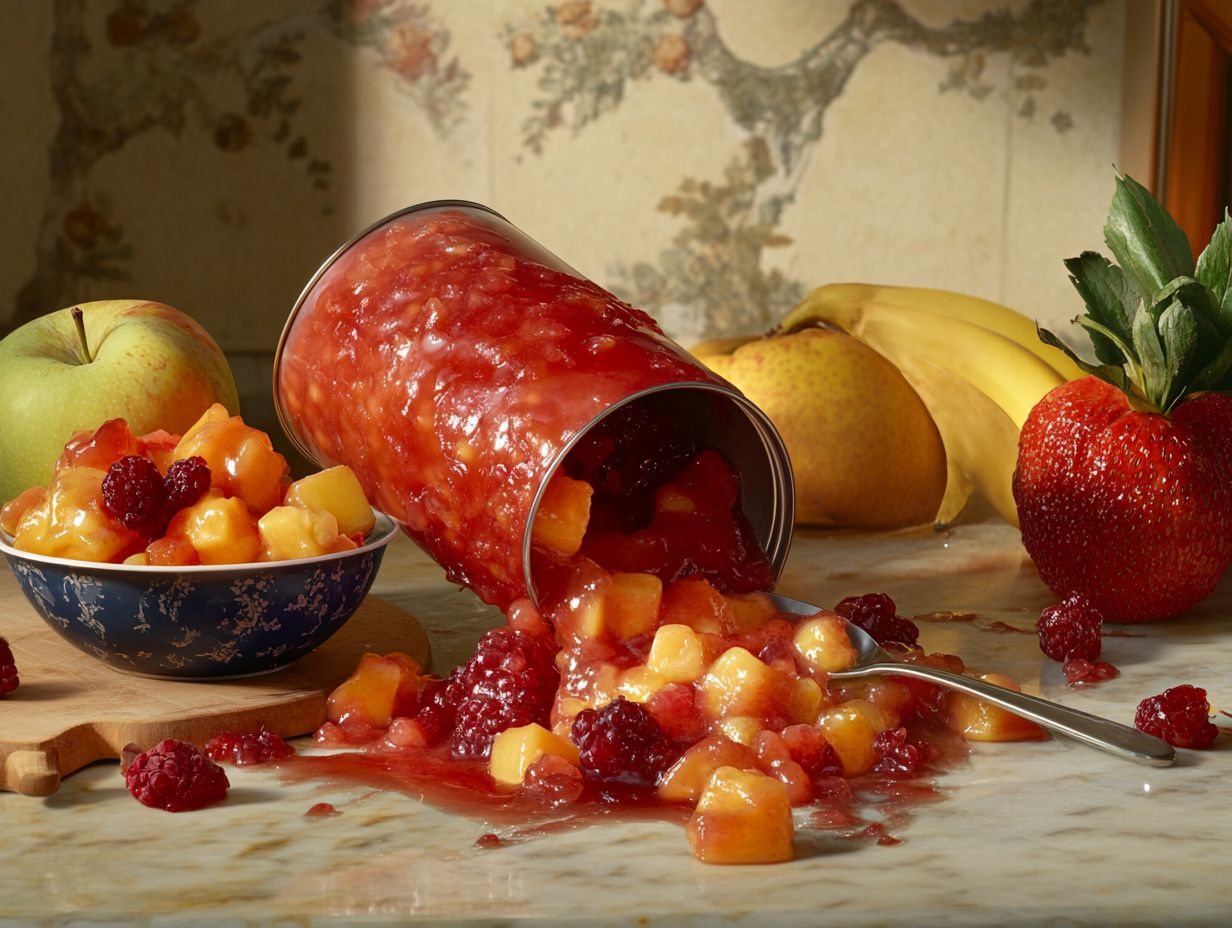
To restore the texture and flavor of overcooked jam, consider adding a touch of extra sugar or lemon juice. These ingredients can elevate the taste and adjust the consistency, transforming the jam back into a delightful spread.
If the mixture has thickened excessively during cooking, incorporating a small amount of water or fruit juice can help thin it out. Re-cooking the jam at a lower temperature offers a gentler method, allowing the flavors to meld harmoniously without the risk of further caramelization.
By employing these techniques, you can easily revive your jam, turning it back into a luscious condiment perfect for spreading on toast or enhancing your favorite desserts and muffins.
Creative Uses for Overcooked Canned Fruits
Transforming overcooked canned fruits into culinary delights can elevate your kitchen game. Repurpose that thick jam into a luscious glaze for your homemade biscuits or integrate it into inventive barbecue sauces. This approach minimizes waste while turning a kitchen mishap into a treasure trove of flavor.
Recipes and Ideas for Repurposing
Recipes for repurposing overcooked jam can take you on a delightful culinary journey, transforming your mishap into everything from delectable homemade biscuits to flavor-packed sweet and tangy barbecue sauces. You ll discover exciting new ways to enjoy your jam.
By embracing your creativity in the kitchen, you can turn what once felt like a disaster into impressive culinary delights that will surely surprise your guests. With a dash of imagination, that overcooked jam can enhance a variety of dishes think fruit-filled pastries, zesty vinaigrettes, or tantalizing glazes for roasted meats.
Whether you re aiming to elevate a savory dish or create a sumptuous dessert, the possibilities are virtually limitless.
So go ahead and experiment; these recipes might just evolve into your new favorites, showcasing the unique flavors of your wonderfully overcooked creation, including apple pie and peach desserts.
Frequently Asked Questions
Here are some common questions related to canning and jam-making:
- What is the best way to store homemade jam?
- How long does homemade jam last?
- Can I use frozen fruits for making jam?
- What should I do if my jam doesn’t set?
In conclusion, don t let your jam go to waste! Explore your creativity in the kitchen and try these methods today!
What causes canned fruits to become overcooked?

Canned fruits can overcook when exposed to too much heat during canning or stored for long periods at high temperatures. This can lead to undesirable results.
How can I tell if my canned fruits are overcooked?
Look for discoloration or a mushy texture. An off-putting odor or taste is also a sign they are overcooked.
Can I salvage overcooked canned fruits?
Sadly, overcooked canned fruits cannot be saved, but if you’re dealing with overripe fruits, you can still make them shine in canning by following some techniques. It’s best to throw away ruined products to avoid health risks. For helpful tips, check out this guide on how to make overripe fruits shine in canning.
How can I prevent canned fruits from overcooking?
Always follow the manufacturer s processing instructions and storage guidelines. Keep the cans away from high heat for extended periods.
Are there health risks with overcooked canned fruits?
Yes, overcooked canned fruits can harbor harmful bacteria or toxins, which may cause food poisoning. Discard them to stay safe.
Can I use overcooked canned fruits in cooking or baking?
Overcooked canned fruits aren’t great for eating, but you can use them in cooking or baking. If you’re dealing with undercooked options, consider checking out fixing undercooked canned vegetables as well. Just be sure to cook them thoroughly to eliminate any harmful substances.


